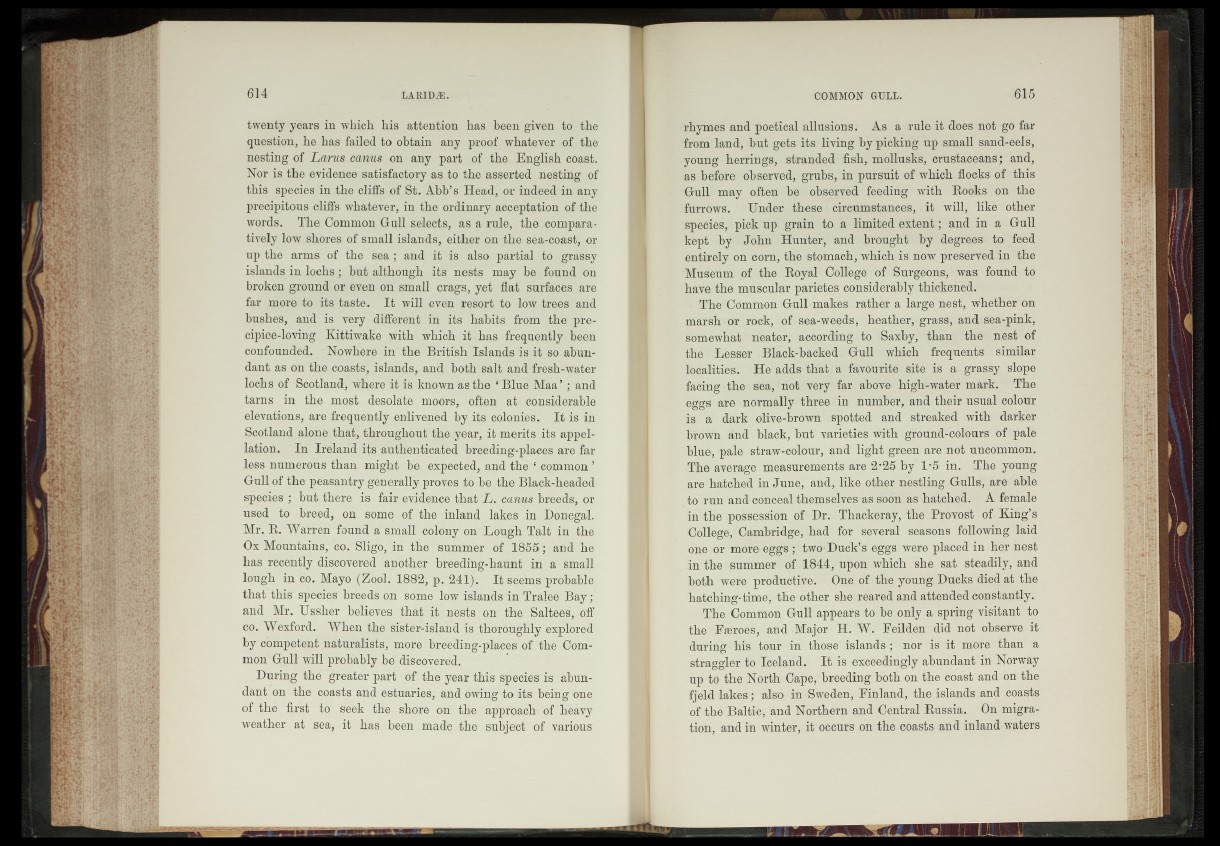
twenty years in which his attention has been given to the
question, he has failed to obtain any proof whatever of the
nesting of Larus canus on any part of the English coast.
Nor is the evidence satisfactory as to the asserted nesting of
this species in the cliffs of St. Abb’s Head, or indeed in any
precipitous cliffs whatever, in the ordinary acceptation of the
Words. The Common Gull selects, as a rule, the .comparatively
low shores of small islands, either on the sea.-coast, or
up the arms of the sea; and it is also partial to grassy
islands in lochs; but although its nests may -he jpund bn
broken ground or even on small crags, yet flat surfaces are
far more to its taste. It -will even resort to low trees' and
bushes, and is very‘different‘in its habits from the precipice
loving Kittiwake with which it has frequently^-been
confounded. Nowhere in the British “Islands is it so. abundant
as on the coasts;, islands, and both salt and fresh-water
lochs of Scotland, where it is known as the ‘ Blue Maa 1; and
tarns in the most desolate moors, g 'often - at fïjqn side,r$,ble
elevations, are frequently enlivened by its colonies. It is jjjjp
Scotland alone that, throughout the -year, it merits;;its appellation.
In Ireland its authenticated "breeding-places are far
less numerous than might- be expected, and the^ common ’
Gull of thé peasantry generally proves to be the Black-headed
species ; but there is fair evidence that L, •zcanus breeds, or
used to breed, on some^bf the inland lakes in Donegal.
Mr. R. Warren found a small' colbny on LbUgh Talt in the
Ox Mountains, co. Sligo, in the summer of 1855'; and he
has recently discovered ’another breéding-haüht ‘in a Small
lough in co. Mayo|^)öï. 1882, p. 241). It m m ] i 1 il h
that this species Breeds oh some low'rslands imTra^e;®8y ;
and Mr. Ussher ’believes, that it nests on the'^Saitées, Off
cm Wexford. .Whenjih,e sistër-island% thóroughlyféxplhré;d
by competent naturalists, more" breehinh-^faëeS -of the Common'Gull
will probably bh discovered.
During the greater part b ï'the year'this spéciés is^abum
dant on’the coasts“ and eïstü'aries; and owing to 'its- being bite
off thé first to" seek fH& shore on- the approach 'of*Heavy
weather at sea, .Ik has '-been.: mad'e. -the..-subject ©f various
rhymes and poetical allusions; As a rule it does not go far
from land, but gets 'its living by picking up small sand-eels,
young herrings, stranded fish, molusks, crustaceans; and,
-as -before observed, grubs, -in pursuit of which flocks of this
Gull may often be- observed feedingbwith Rooks on the
furrows. Under these -, circumstances, it will, like other
species, pick up grain to a limited extent; and in a Gull
kept by :.3ohn Hunter, and brought-by degrees, to' feed
entirely oh corn, the stomach, which*Is now preserved-in the
Museum of the Royal CollegeI of Surgeons,1 was found to
have the muscular parietes considerably tbic^eftd.^
il ’The Common Gull makes rather-a large’‘nest“, -whether on
marsh Orf rock,:ofsea-weeds, heather,-grass, and.sea-pink,
somewhat' neater,'-according .to'Saxby, than the . nest of
the^Eesser Black- backed; Gull which frequents similar
todalitiesV’" He adds that a • favourite Wm is a grassy slope
facing-the sea;*not‘ very far above high-water mark. The
%ggs-’ are normally three in number, and their .usual colour
is a dark olive-brown .spotted"5' and streaked with darker
Brown and black,'-but" varieties with .ground-colours ,bf pale
blue, pale straw-colour,' and light-green- afe..not uncommon.
•The average measurements. are:2*25 by' 1*5' in. The young
are hatched in Ju n |f and, like other nestling .Gulls, .are: able
to' run and bonceabtbemselves-as soonJas hatched.' A’ female
in the .possession of Dr. ! Thackeray, the .‘Provost of. King’s
College,^Cambridge, had for several .seasons .-following laid
one or more 'eggs'V two*Duck’s eggs/wpe placed in her'.neSfc
in-the'.summer of , 1844, upon-which she sat steadily, and
both were productive^- One\of the young -Ducks died at the
hatching-time,-; the' other she(reared and attended constantly.
. -The Common Gull ap.pe$rsl|of be ioi% .'a spring visitant fm\
the EserooS/- andvMajOr H. W. Peilden. did not .observe it
during-bis tour in thosef. islands; nor-is it more than a
'straggler-ffo Iceland'.' Tths exceedingly Abundant in. Norway
up to thefflrth Cape,-breeding both ondhe;,coast and. on the
fjeld lakes-; ates » Sweden, Finland, the islands and .coasts
.‘offthe Baltic, and Northern and Central Russia.. On .migration,
and in winter; itoccurs on the eoAS$soand inland, waters